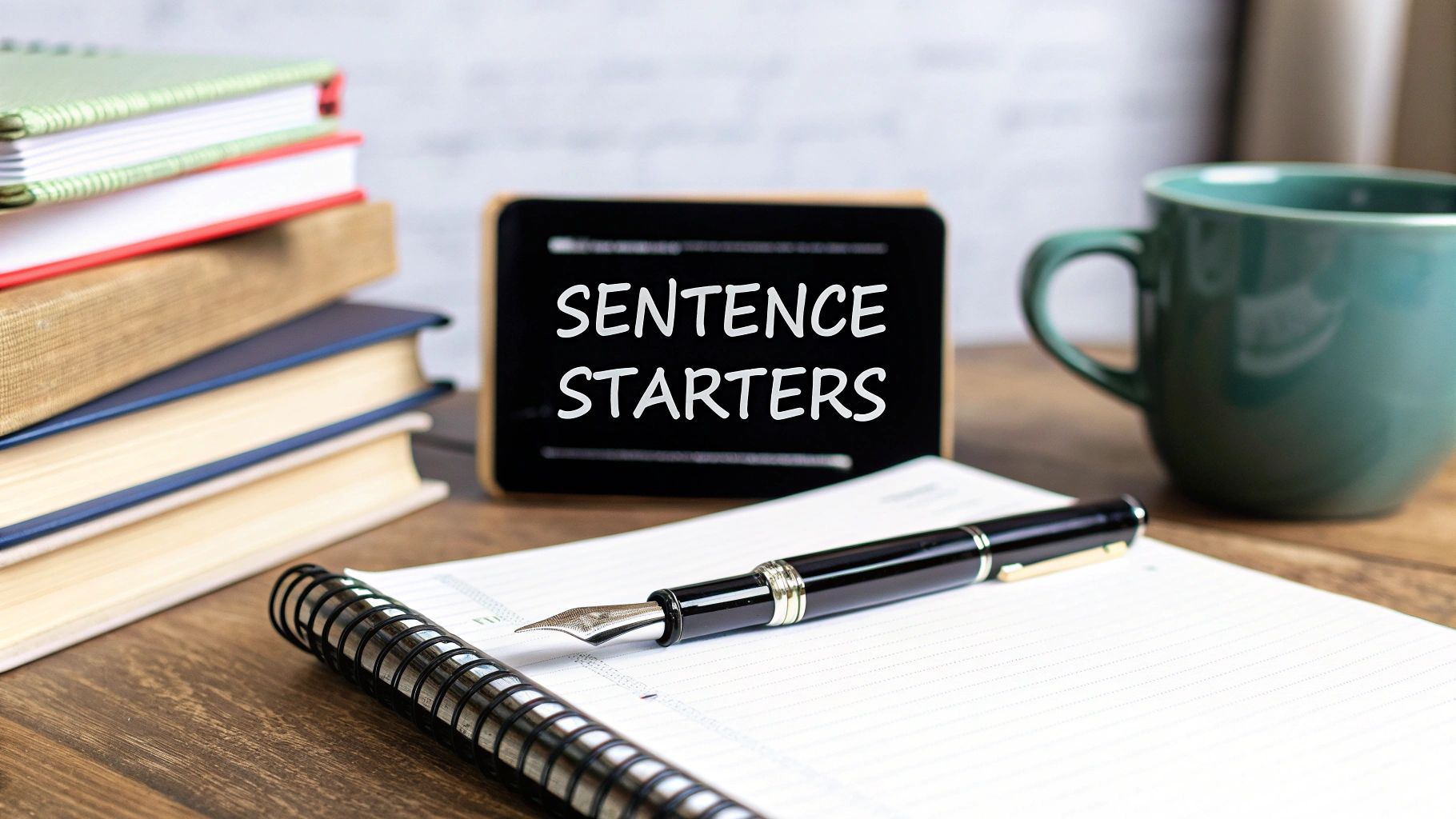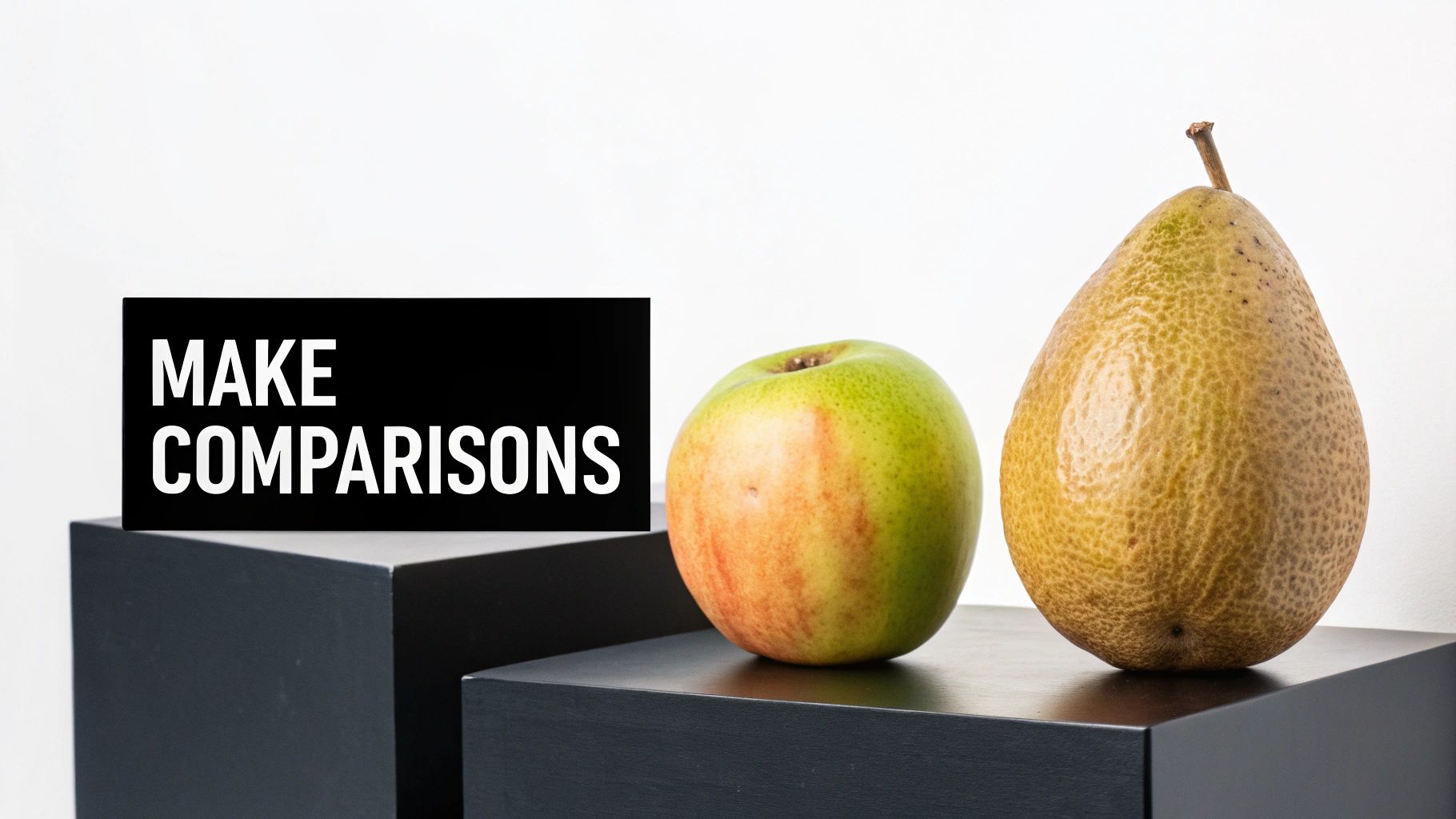
10 Effective Examples of Sentence Starters to Improve Your Writing
Published on 2025-05-04
Unleash the Power of Sentence Starters
Do you ever struggle to write that perfect first sentence? This listicle provides examples of sentence starters to help you craft engaging content. Discover seven categories of sentence starters that add variety and enhance readability. Learn how to use transitional, question-based, evidence-based, descriptive, personal reflection, thesis/argument, and comparative sentence starters. Mastering these examples of sentence starters will elevate your writing and captivate your audience from the start.
1. Transitional Sentence Starters
Transitional sentence starters are essential tools for creating clear, cohesive, and professional writing. They act as bridges between ideas, guiding the reader smoothly from one thought to the next. These phrases explicitly signal the relationship between sentences and paragraphs, clarifying whether the subsequent thought expands on the previous one, contrasts with it, or presents a consequence or example. This logical flow enhances readability and ensures that your message is easily understood. Examples of sentence starters like "furthermore," "in contrast," "similarly," and "consequently" are invaluable for establishing these connections. This approach is particularly important for online content where maintaining reader engagement is paramount.

Transitional sentence starters serve several key functions. They indicate the relationship between ideas, whether it be addition (furthermore, moreover), contrast (however, conversely), exemplification (for instance, for example), or conclusion (therefore, in summary). They create cohesion within the text, binding sentences and paragraphs together into a unified whole. Crucially, they help guide the reader through the logical progression of your argument or narrative, ensuring that the intended meaning is conveyed effectively. This feature is particularly important for longer-form content, such as blog posts or LinkedIn articles, where maintaining a clear structure can be challenging.
For LinkedIn content creators, social media managers, and other marketing professionals, using transitional sentence starters is a best practice for producing high-quality, engaging content. Improving readability and flow keeps readers hooked, increasing the likelihood that they will consume the entire piece and take desired actions, such as sharing the post or visiting your website. Clarifying the relationships between ideas strengthens your arguments and makes your message more persuasive. For entrepreneurs, small business owners, founders, and CEOs crafting their own content, these tools can elevate your communication, projecting a professional and polished image.
Examples of Successful Implementation:
- Adding Information: "Furthermore, this new marketing strategy will allow us to reach a wider audience."
- Contrasting Ideas: "In contrast to traditional advertising, social media marketing offers more targeted reach."
- Showing Similarity: "Similarly, our competitors have begun to adopt this approach."
- Indicating Consequence: "Consequently, the results of the campaign exceeded our expectations."
Tips for Using Transitional Sentence Starters:
- Vary Your Phrases: Avoid overusing the same transitions. A diverse vocabulary will keep your writing fresh and engaging.
- Choose Precisely: Select transitions that accurately reflect the relationship between ideas. Don't use "however" when "furthermore" is more appropriate.
- Use Sparingly in Narrative: In storytelling, excessive transitions can disrupt the flow. Rely more on context and pacing.
- Place at the Beginning: For maximum impact and clarity, place transitional phrases at the beginning of sentences.
Pros:
- Improves readability and flow
- Clarifies relationships between ideas
- Organizes thoughts for both writer and reader
- Creates professional, polished writing
Cons:
- Can become repetitive if overused
- May feel mechanical if not varied
- Some transitions can be ambiguous without context
Transitional sentence starters deserve a prominent place on this list because they are fundamental to effective communication. Mastering their use will significantly enhance the clarity, coherence, and impact of your writing. Learn more about Transitional Sentence Starters. By strategically incorporating these linguistic tools, you can ensure your message resonates with your target audience and achieves its intended purpose. They truly are valuable examples of sentence starters.
2. Question-Based Sentence Starters
Question-based sentence starters are a powerful way to draw readers in and encourage them to think critically about your content. They begin with an interrogative phrase, posing a question directly to the reader and prompting them to consider the topic from a specific perspective. This technique creates immediate engagement and sets the stage for you to provide answers, analysis, or further exploration of the subject matter. It's a dynamic approach that can elevate your writing, whether you're crafting a LinkedIn post, an academic paper, or a compelling story.

This method works by tapping into the reader's natural curiosity. By presenting a question, you invite them into a conversation, creating a sense of dialogue even in written communication. This conversational tone fosters a connection with the audience and makes your content more accessible and engaging. Moreover, question-based starters naturally lend themselves to a problem-solution structure, where the question presents the problem and the subsequent text offers the solution or analysis. This structure is particularly effective for conveying complex information in a clear and concise manner. For example, starting a paragraph with "What are the key challenges facing small businesses today?" immediately focuses the reader's attention and prepares them for the insights you'll be sharing.
Examples of effective question-based sentence starters include:
- Why do so many organizations struggle with digital transformation?
- How can we reconcile these contradictory findings?
- What would happen if this technology were widely adopted?
- Have you ever wondered why this phenomenon occurs?
These examples demonstrate the versatility of question-based starters, applicable to both factual analysis and prompting personal reflection. For LinkedIn content creators, social media managers, and entrepreneurs, this technique can be particularly valuable for sparking discussion and boosting engagement. Imagine starting a LinkedIn post with "What's the biggest obstacle you've faced in building your brand?" – such a question immediately invites comments and fosters a sense of community.
Tips for Effective Implementation:
- Follow the question with a clear answer or exploration: Don't leave your readers hanging. Provide thoughtful responses or analysis to the questions you pose.
- Use rhetorical questions sparingly in formal writing: While effective for emphasis, overuse can diminish their impact.
- Consider the question from the reader's perspective: Ask yourself if the question is genuinely relevant and interesting to your target audience.
- Ensure the question is relevant to your main argument: The question should serve a purpose in advancing your overall message.
Pros and Cons:
Pros: Captures attention quickly, creates a dialogue with the reader, useful for introducing new topics, effective for rhetorical emphasis.
Cons: Can seem informal in highly academic contexts, may create expectations for direct answers, not always appropriate for formal reports or certain academic disciplines.
Question-based sentence starters deserve their place in this list because they offer a powerful and versatile tool for engaging readers and enhancing the impact of your writing. This method, popularized through techniques like the Socratic method, journalistic writing, and the presentations of TED Talks and public speakers, offers a proven path to capturing attention and fostering connection. Learn more about Question-Based Sentence Starters and explore how they can elevate your communication.
3. Evidence-Based Sentence Starters
Evidence-based sentence starters are crucial for adding weight and credibility to your writing. They introduce factual information, research findings, statistics, or expert opinions to support your claims. These starters signal to readers that the content that follows is grounded in credible sources, not just personal opinion, which is essential for building trust and persuading your audience. This makes them invaluable tools for anyone creating content, from LinkedIn thought leadership posts to marketing copy.

These sentence starters work by directly referencing a reputable source or piece of data before making a point. This immediately establishes the basis for your argument and demonstrates that you're not just making assertions without backing them up. For instance, instead of writing "Social media marketing is important," you could write "According to a recent HubSpot report, 73% of marketers find social media marketing effective for their business." This instantly adds credibility and strengthens your statement.
Examples of successful implementation:
- According to recent research by Stanford University..., (This establishes the research institution as the source of authority.)
- The data clearly demonstrates that..., (This emphasizes the objective nature of the supporting evidence.)
- As evidenced by the 2023 industry report..., (This points to a specific, verifiable report.)
- Studies conducted by Dr. Chen reveal that..., (This highlights the expertise of the individual behind the research.)
- A survey of 500 CEOs found that... (This specifies the scope and participants of the research.)
Actionable tips for using evidence-based sentence starters:
- Always verify your sources: Ensure the accuracy and reliability of your data before using it.
- Vary your approach: Don't rely on the same phrases repeatedly. Experiment with different introductory phrases to keep your writing engaging. For example, try "Research suggests...", "Data analysis indicates...", or "Expert opinions confirm...".
- Explain the significance: After presenting evidence, clearly explain its relevance to your argument. Don't just drop in a statistic and move on.
- Use appropriate citation style: Follow the appropriate citation guidelines for your field or publication (e.g., APA, MLA, Chicago).
- Consider your audience: While crucial for academic and scientific writing, evidence-based starters are also incredibly effective for content aimed at professionals on platforms like LinkedIn. They help position you as a thought leader by demonstrating your knowledge and commitment to data-driven insights.
When and why to use this approach:
Evidence-based sentence starters are particularly effective in:
- Academic writing: Essential for research papers, essays, and dissertations.
- Scientific writing: Crucial for communicating research findings and building scientific consensus.
- Data journalism: Forms the backbone of data-driven reporting.
- Business reports and presentations: Adds credibility and strengthens recommendations.
- Marketing and advertising: Provides factual support for claims about product effectiveness or market trends.
- LinkedIn and other professional platforms: Positions you as a credible voice in your industry.
Pros:
- Strengthens arguments with data
- Builds credibility with readers
- Creates clear attribution of ideas
Cons:
- Can feel mechanical if overused
- May interrupt narrative flow in creative writing
- Requires accurate sourcing and citation
This approach deserves a prominent place on this list because it elevates the impact of your writing by grounding it in verifiable facts. For anyone creating content intended to inform, persuade, or establish authority, evidence-based sentence starters are an indispensable tool. They are particularly important for LinkedIn content creators, social media managers, marketing professionals, entrepreneurs, small business owners, founders, and CEOs looking to build trust and influence their audience.
4. Descriptive/Sensory Sentence Starters
Descriptive/sensory sentence starters are a powerful tool for drawing readers into your content. They leverage vivid sensory details and imagery to immediately immerse the audience in a scene or experience. By appealing to the five senses—sight, sound, touch, taste, and smell—these starters create engaging content that resonates on a deeper level, making them particularly effective for creative writing, storytelling, and persuasive pieces. Instead of simply stating a fact, descriptive starters show the reader what you mean, making abstract concepts concrete and increasing emotional engagement. This technique is valuable for anyone crafting compelling content, from LinkedIn posts to marketing copy. These starters provide examples of sentence starters that truly captivate.

Descriptive sentence starters often employ literary devices like simile or metaphor to further enhance the imagery. For instance, instead of writing "The room was quiet," you might write, "Like a sheet of glass shattering in slow motion, the silence broke when she spoke." This not only conveys the quiet but also the sudden disruption of it. Other examples include:
- Sight: Bathed in golden afternoon light, the ancient building seemed to breathe with history...
- Smell: The sharp tang of citrus cut through the air as she entered the kitchen...
- Sound: Beneath our feet, the wooden floorboards creaked with stories of generations past...
- Touch: The smooth, cool surface of the marble countertop felt luxurious beneath her fingertips...
Tips for Using Descriptive/Sensory Sentence Starters:
- Match sensory details to the tone and purpose of your writing. A lighthearted blog post might use playful sensory descriptions, while a more serious piece requires a different approach.
- Focus on unexpected or specific details rather than generic descriptions. "The red flower bloomed" is less impactful than "The crimson petals unfurled like a velvet cloak, revealing a heart of gold."
- Use sensory starters to transition between scenes or to introduce important locations. This helps ground the reader in the narrative and creates a more immersive experience.
- Consider which sense would most powerfully convey the experience you're describing. If you're writing about a bakery, the smell of freshly baked bread might be the most evocative detail.
Pros and Cons:
- Pros: Creates an immersive reading experience, makes abstract concepts concrete, increases emotional engagement, particularly effective for narrative and creative writing.
- Cons: Can be inappropriate for technical or formal academic writing, may seem flowery or excessive if overused, can distract from the main point if too elaborate.
This technique, popularized by literary giants like Toni Morrison and Gabriel García Márquez, as well as nature writers like Annie Dillard, has become a cornerstone of compelling storytelling. For content creators, marketers, and entrepreneurs, mastering descriptive sentence starters can significantly elevate the quality and impact of their work, whether it's a LinkedIn article, a social media post, or a website's landing page.
5. Personal Reflection Sentence Starters
Personal reflection sentence starters are powerful tools for injecting authenticity and personal voice into your writing. They introduce subjective experiences, opinions, or insights, signaling to readers that what follows is your unique perspective. This creates opportunities for a genuine connection with your audience by tapping into shared human experiences. As such, they deserve a prominent place on this list of examples of sentence starters because they offer a way to make your content relatable and engaging.
How They Work:
Personal reflection starters often use first-person pronouns like "I," "me," and "my" to establish your presence in the narrative. They frame the subsequent information as being filtered through your individual lens, adding a layer of personal meaning. This is particularly valuable for LinkedIn content creators, social media managers, and entrepreneurs seeking to build stronger relationships with their audience.
Examples of Successful Implementation:
- In my experience working with startups, funding is often the biggest hurdle.
- I've always believed that strong leadership is essential for a successful team.
- Looking back on my career trajectory, I realize the importance of mentorship.
- When I consider the impact of social media on marketing, I see both opportunities and challenges.
- From my perspective, the future of [your industry] lies in [your prediction].
These examples demonstrate how personal reflection starters can be used to introduce a variety of topics, from professional insights to personal beliefs.
Actionable Tips for Readers:
- Balance Personal Reflection with Evidence: While personal experience is valuable, back up your claims with data, statistics, or examples to strengthen your arguments. This is especially important for marketing professionals and CEOs who need to project credibility and authority.
- Be Authentic, But Maintain Appropriate Boundaries: Share personal experiences that are relevant to your topic and audience. Avoid oversharing or revealing information that is too personal or inappropriate for the context.
- Use Personal Starters to Establish Credibility: Share relevant experiences to demonstrate your expertise. For example, a founder might share their experience overcoming a business challenge to establish their credibility as a thought leader.
- Consider Your Writing Context: First-person is appropriate for blog posts, personal essays, and social media content. However, it may not be suitable for formal academic writing or some professional reports.
When and Why to Use This Approach:
Personal reflection starters are particularly effective for:
- Creating Authentic Connection with Readers: Sharing your personal experiences makes you relatable and builds trust with your audience.
- Humanizing Complex or Abstract Topics: Personal anecdotes can make difficult concepts more accessible and understandable.
- Effective Persuasive Writing and Personal Essays: Sharing your beliefs and experiences can add emotional weight to your arguments.
- Making Content Relatable and Accessible: Personal reflections can break down barriers between you and your readers, fostering a sense of shared understanding.
Pros:
- Creates authentic connection with readers.
- Humanizes complex or abstract topics.
- Effective for persuasive writing and personal essays.
- Makes content relatable and accessible.
Cons:
- May be inappropriate for some formal academic writing.
- Can weaken arguments if not balanced with evidence.
- Requires discernment about appropriate personal disclosure.
By thoughtfully incorporating personal reflection sentence starters, you can elevate your writing, connect with your audience on a deeper level, and create content that resonates. This is a powerful tool for anyone looking to build a stronger online presence, whether they are LinkedIn content creators, social media managers, or entrepreneurs building their brand.
6. Thesis/Argument Sentence Starters
Thesis/Argument sentence starters are crucial for establishing a clear position and guiding the reader through a structured presentation of ideas. They serve as the foundation upon which the rest of your writing will build, providing direction and focus. These examples of sentence starters immediately signal your intent, whether you're crafting a LinkedIn article, a blog post, or a more formal piece of writing. They are especially valuable for anyone creating persuasive content, including LinkedIn content creators, social media managers, marketing professionals, entrepreneurs, small business owners, founders, and CEOs.
These starters explicitly state your central argument or claim, setting the stage for the supporting evidence that follows. They typically appear early on, often in the introductory paragraphs, giving the reader a roadmap of your key points. This is essential for grabbing the reader's attention and providing a clear sense of purpose.
How They Work:
Thesis/Argument sentence starters work by presenting a concise and debatable statement. This statement acts as a compass, guiding the flow of information and ensuring all subsequent points contribute to supporting the central argument. They create an expectation of logical progression and evidence-based reasoning.
Examples of Successful Implementation:
- Academic Context: "This paper argues that renewable energy adoption faces three primary barriers: cost, infrastructure, and public perception."
- Business Context: "I contend that investing in employee training yields a significant return in both productivity and employee retention."
- Marketing Context: "The evidence suggests that traditional approaches to marketing fail to address the evolving needs of the modern consumer."
- LinkedIn Article Context: "This analysis will demonstrate that social media engagement is a key driver of brand awareness and customer loyalty."
Actionable Tips:
- Specificity: Make your thesis specific and debatable. Avoid simply stating facts. For instance, instead of "Social media is popular," try "Targeted social media campaigns are more effective than traditional advertising for reaching niche demographics."
- Supportability: Ensure your argument can be supported with available evidence. Don't make claims you can't back up.
- Consider Counterarguments: Acknowledging potential counterarguments strengthens your position and demonstrates a nuanced understanding of the topic.
- Revision: Revise your thesis as your understanding of the topic develops during the writing process.
When and Why to Use This Approach:
Use Thesis/Argument sentence starters when you need to present a clear, persuasive argument. This is particularly relevant in:
- Persuasive writing: Convincing readers to adopt a specific viewpoint.
- Academic writing: Presenting research findings and supporting arguments.
- Business proposals: Justifying a proposed course of action.
- LinkedIn articles: Establishing thought leadership and sharing industry insights. Learn more about Thesis/Argument Sentence Starters
Pros:
- Establishes clear purpose and direction.
- Helps readers anticipate the structure of your argument.
- Creates accountability for providing supporting evidence.
- Essential for persuasive and academic writing.
Cons:
- Can prematurely narrow discussion if introduced too early.
- May create expectations for a formal structure that limits creativity in some contexts.
- Can seem confrontational if not worded carefully.
Thesis/Argument sentence starters deserve a prominent place on this list because they are fundamental to effective communication, particularly in professional and academic settings. They offer a powerful way to structure your writing, engage your audience, and present a compelling case for your ideas. They are invaluable tools for anyone seeking to influence or persuade through the written word.
7. Comparative Sentence Starters
Comparative sentence starters are powerful tools for anyone crafting compelling content, from LinkedIn thought leaders to marketing professionals. They allow you to draw insightful connections between different ideas, products, or even market trends, adding depth and analytical weight to your writing. This makes them an essential element in any list of effective examples of sentence starters. By highlighting similarities, differences, or relative qualities, these starters create a framework for analysis that helps your audience grasp complex relationships and evaluate various perspectives. This is crucial for engaging readers and positioning yourself as a thought leader in your field.
How They Work:
Comparative sentence starters establish a basis for comparison, signaling to the reader that you are about to analyze two or more elements. They often employ comparative or superlative adjectives (like "better," "worse," "faster," "slower," "most innovative," "least effective") or comparative conjunctions (like "while," "whereas," "although," "similarly"). This sets the stage for a structured comparison, enabling you to present information in a clear and organized manner.
Examples of Successful Implementation:
- Product Comparison: "Unlike traditional project management software, our platform integrates seamlessly with your existing CRM, saving you time and streamlining your workflow."
- Market Analysis: "While both companies offer similar services, Company A focuses on sustainable practices, giving them a competitive edge in the current market."
- Thought Leadership: "More effective than previous strategies, this new approach to content marketing leverages AI-powered insights to personalize the user experience."
- Academic Writing: "When compared to its predecessors, this new research reveals a significant correlation between social media engagement and consumer purchasing behavior."
Actionable Tips for Using Comparative Sentence Starters:
- Ensure Comparability: Make sure the elements you're comparing are logically comparable. Comparing apples to oranges will confuse your audience and weaken your argument.
- Establish Clear Criteria: Define the specific criteria you're using for comparison. For example, are you comparing products based on price, performance, or features?
- Consider Visual Aids: For complex comparisons, using charts, graphs, or tables can enhance clarity and make the information more digestible.
- Avoid False Equivalencies: Be mindful of creating false equivalencies, especially when dealing with complex issues. Nuance is key.
When and Why to Use This Approach:
Comparative sentence starters are particularly valuable in situations where you need to:
- Analyze complex information: They provide a structure for breaking down complex topics into manageable comparisons.
- Evaluate competing perspectives: They allow you to present different viewpoints and assess their relative merits.
- Synthesize multiple sources: They help you integrate information from various sources into a cohesive analysis.
- Persuade your audience: By presenting clear comparisons, you can build a strong case for your argument.
Pros and Cons:
Pros:
- Helps organize complex information
- Creates a clear analytical framework
- Effective for evaluation and critical analysis
- Useful for synthesizing multiple sources or perspectives
Cons:
- Can oversimplify complex relationships if not carefully constructed
- May create false equivalencies if comparisons are not appropriate
- Requires careful selection of comparable elements
Popularized By:
Comparative sentence starters are commonly used in academic analysis, review articles, product comparisons, and comparative literature/cross-cultural studies. They are also increasingly prevalent in marketing and business content, where clear and concise communication is essential.
By mastering the art of comparative sentence starters, you can elevate your writing, engage your audience, and establish yourself as a discerning voice in your field. They provide a powerful way to add depth, analysis, and persuasive power to your content, making them a valuable tool for anyone seeking to communicate effectively.
7 Types of Sentence Starters Compared
| Sentence Starter Type | Implementation Complexity 🔄 | Resource Requirements ⚡ | Expected Outcomes 📊 | Ideal Use Cases 💡 | Key Advantages ⭐ |
|---|---|---|---|---|---|
| Transitional Sentence Starters | Low - Simple to apply, but requires variety | Minimal - Built from common phrases | Smooth flow and logical connections between ideas | Academic, professional writing, narratives | Enhances readability and cohesion |
| Question-Based Sentence Starters | Medium - Crafting relevant questions takes care | Low - No extra data needed | Engages readers, sets up exploration or analysis | Creative writing, speeches, introductions | Captures attention and fosters reader interaction |
| Evidence-Based Sentence Starters | Medium to High - Needs accurate sourcing | Moderate - Requires research and citation | Builds credibility and supports arguments | Academic, scientific, data-driven writing | Strengthens argumentation with authoritative support |
| Descriptive/Sensory Sentence Starters | Medium - Requires vivid, specific details | Moderate - Creative thinking required | Creates immersive, evocative imagery | Creative writing, narratives, persuasive content | Enhances emotional engagement and imagery |
| Personal Reflection Sentence Starters | Low - Based on personal insight | Low - Relies on writer’s experience | Builds authenticity and relatable voice | Personal essays, blogs, persuasive writing | Establishes connection and humanizes topics |
| Thesis/Argument Sentence Starters | Medium - Requires clear, debatable stance | Moderate - Needs evidence for support | Clarifies position and guides structured argument | Academic papers, persuasive essays, formal writing | Provides clear focus and direction |
| Comparative Sentence Starters | Medium - Needs logical criteria and balanced view | Moderate - Requires analysis of elements | Enables critical evaluation and structured analysis | Reviews, academic comparisons, analytical writing | Organizes complex information and clarifies contrasts |
Level Up Your Writing Today
This article explored seven powerful categories of sentence starters: transitional, question-based, evidence-based, descriptive/sensory, personal reflection, thesis/argument, and comparative. Mastering these examples of sentence starters empowers you to craft compelling content that captures attention and resonates with your audience. By diversifying your sentence beginnings, you can create a natural flow, enhance clarity, and inject personality into your writing. These skills are crucial for anyone creating content, whether it's a concise social media update or a long-form blog post. Want to see how sentence starters can be used strategically by some of the biggest brands? Check out these examples: how industry giants leverage clear positioning from Master Your Brand’s Tone of Voice for Real Impact by Unmarked Vision. These insights demonstrate how effective sentence structure contributes to clear brand positioning and impactful messaging.
The most important takeaway is that strategic sentence construction significantly elevates the quality and effectiveness of your communication. From captivating LinkedIn posts to persuasive marketing copy, strong sentence starters create a foundation for engaging content that informs, persuades, and inspires. So, take these examples of sentence starters and begin experimenting with them in your own writing. See how a conscious effort to vary and strengthen your openings can transform your content and amplify your message.
Ready to streamline your content creation process and explore even more diverse sentence structures? autoghostwriter can help you generate high-quality content quickly and efficiently, providing a wealth of diverse sentence starters and phrasing options to further enhance your writing. Explore the power of autoghostwriter today and unlock your full content creation potential!